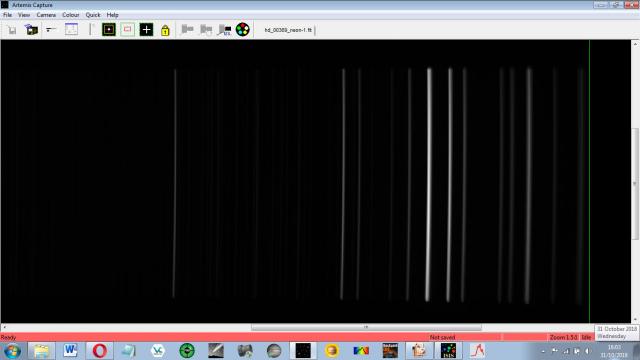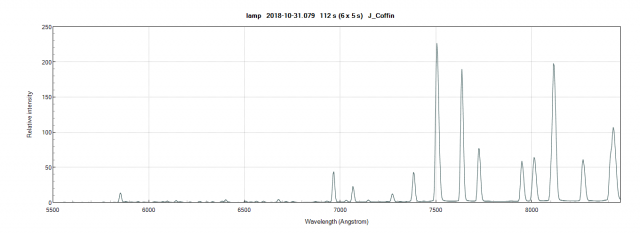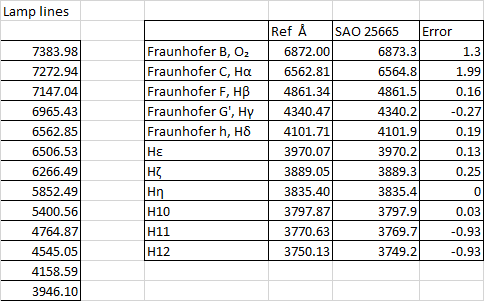› Forums › Spectroscopy › What wavelength error is acceptable with an Alpy?
- This topic has 52 replies, 5 voices, and was last updated 7 years, 1 month ago by
 Robin Leadbeater.
Robin Leadbeater.
-
AuthorPosts
-
31 October 2018 at 2:01 pm #580153
 Dr Andrew SmithParticipant
Dr Andrew SmithParticipantSimple answer is I don’t know.
Can you process a calibration frame as if it were a star? Rename it so ISIS is not confused. Are the lines in the right place?
If they are then I can only think it is the fact that the calibration light is not illuminating the spectrograph in the same way as the star.
If the are not then it may be other issues like undersampling.
Regards Andrew
31 October 2018 at 4:16 pm #580154 John CoffinParticipant
John CoffinParticipantHi Andrew, I’ve processed the calibration image as is if were a star, of course I had to use the same image to calibrate it. The result was odd, but the neon 6965 line was incorrectly calibrated.

The lines are broad and fuzzy in this area, so perhaps I need to focus it better there?

I understand that if I do this I will lose definition at the blue end of the spectrum. Thank you for your thoughts on this issue. I am very grateful for everyone’s input into this.
I’ve attached the files of these images.
Regards, John
31 October 2018 at 5:08 pm #580156 Robin LeadbeaterParticipant
Robin LeadbeaterParticipantHi John,
“I’ve processed the calibration image as is if were a star, of course I had to use the same image to calibrate it. The result was odd, but the neon 6965 line was incorrectly calibrated.”
The spectrum plot looks odd. Did you tick “sky not removed” If you don’t do this it subtracts the lines from them selves, leaving almost nothing behind)
Robin
31 October 2018 at 5:11 pm #580155 Robin LeadbeaterParticipant
Robin LeadbeaterParticipantHi John
“Last night’s specrum of Pi Andromeda (HD 00369) was still about 3 A out at H alpha but very accurate from H beta to epsilon. “
I presume this was using the mix of lamp lines and Balmer lines for calibration?. If so, the Balmer lines from H Beta down will always be in exactly right the right place because ISIS used them for calibration.
Similarly if you just used the lamp lines for calibration and produce a spectrum of the lamp, I suspect you will find that the lamp lines are in exactly the right place (within the accuracy of the fit ~+-0.5A)
The problem arises when we use lamp lines to calibrate star spectra. There is a shift somewhere between the star spectrum and lamp spectrum. Based on the latest result this does not seem to be a stability problem.
There are differences between the optical paths for lamp and star which could produce small systematic shifts. We may have found the limit of absolute accuracy of using the internal lamp for calibration. (note this is a systematic error, not a lack of precision/repeatability so not a problem when studying changes in wavelength eg in radial velocity measurements of binary stars.)
To take this further I would say we would first need to compare results from other ALPYs to determine if it is a limitation of the instrument or if this particular example is worse for some reason. Since I am seeing signs of similar size errors in star lines with my ALPY when using just the internal lamp, I suspect it could be a limit in absolute accuracy. In which case there is no need to be overly concerned but longer term there may be some modifications that could be made to the ALPY or the calibration technique to improve the calibration accuracy further.
Using a mix of lamp and star for calibration confuses the issue. I would say The definitive test would be for ALPY owners to take a spectrum of a star with known reliable RV, Calibrate just using the internal lamp and look for errors in the star lines.
This could be a good project for the workshop
Cheers
Robin
31 October 2018 at 6:32 pm #580157 John CoffinParticipant
John CoffinParticipantNo, I didn’t tick that box. Here is the new improved lamp spectrum which looks accurate. I noticed that the intensity of the lines that ISIS uses for calibration are much weaker than those above 7000 A. Perhaps I should not worry about saturating those brighter lines and try using a longer exposure in order to make the ones used by ISIS brighter.

What do you think is the way forward now? I was hoping to submit spectra to our database. Should I put a comment in the FITs header about the calibration method and its (?) inherent problems, ie mixed method with accuracy upto H beta, 3A blueshift near H alpha.
What would be the best way to calibrate now? Would it depend on the nature of the target?
31 October 2018 at 8:26 pm #580158 Robin LeadbeaterParticipant
Robin LeadbeaterParticipantHi John,
I wouldn’t hold back from submitting spectra. (You could have a look in the databases for other ALPY spectra to see how their calibration looks.) I think a wavelength calibration accuracy of ~1/4 the resolution is still good (At the end of the day my ALPY spectra using just the lamp lines are no more accurate. The errors are just at the other end of the wavelength range). There is still something niggling to do with the difference in how the ALPY sees the lamp compared with the star to nail down here but I suspect it will turn out to be something common to ALPYs in general.
Dont refocus to sharpen up the lines in the far red to the detriment of the blue end. The ALPY performance is biased towards the blue end where it actually outperforms the LISA
I think ISIS is finding the lines OK so exposing more probably will not make much difference but exposing for the brightest line that ISIS uses is a good idea and if you want to try going further you can sum several exposures to increase the signal/noise in the faint lines in the same way as summing flats works (I used to do this but the results using just one well exposed lamp exposure seemed to work just as well.)
Cheers
Robin
31 October 2018 at 10:11 pm #580159 John CoffinParticipant
John CoffinParticipantThanks for all your advice. Much appreciated!
John
1 November 2018 at 10:20 am #580163 Dr Andrew SmithParticipant
Dr Andrew SmithParticipantI would avoid using the star plus lines method as it is mixing two different dispersion if the light path is different between the two.
I think it would be best to use the lines to get the dispersion then adjust any offset with an A star. The ALPY with Ne Ar has enough lines without the star lines for a good fit.
Regards Andrew
1 November 2018 at 10:57 am #580164 Robin LeadbeaterParticipant
Robin LeadbeaterParticipantYes I only use the lamp lines. The fit does deteriorate below 3900A though. (The lowest line ISIS uses) which is why Buil added the mixed star and lamp option
http://www.astrosurf.com/buil/isis/guide_alpy/resume_calibration.htm
see comparison of methods 2 and 3
Cheers
Robin
1 November 2018 at 11:37 am #580165 David BoydParticipant
David BoydParticipantMy understanding is that the mixed method (lamp + Balmer lines) was used in ISIS to compensate for the original Ne-only lamp bulbs only having usable lines at the red end. When Shelyak introduced the replacement Ar-Ne bulbs, I was told that method was redundant and I should just use the lamp lines. In my LISA the Ar-Ne bulb produces sufficient lines across the whole spectrum to use for calibration without needing a stellar spectrum. I always had problems getting a good result with the mixed method and found using just the Ar-Ne lines worked much better.
I probably missed it somewhere in the earlier discussion whether John’s lamp has the Ar-Ne bulb. Some of these bulbs can deteriorate over time so it may be worth asking Francois Cochard at Shelyak if the emission line spectrum you get from the Alpy calibration module is what he expects to see. I’ve found Francois very willing to help resolve problems like that.
One small point on an earlier posting by Robin. Robin said “I see the wavelengths I posted (and listed by ISIS in the reports) are the values calculated from the fit, not the true values”. In my experience, the lambda values which ISIS lists in the report are the true wavelength values you give it for the lines. The dlambda values are the corrections it has applied to these values to get the best fit.
David
1 November 2018 at 12:37 pm #580167 Robin LeadbeaterParticipant
Robin LeadbeaterParticipantI like Andrew’s idea of calibrating using the lamp and then ofsetting the spectrum to match the star lines. This is similar to what is done with the LHIRES where telluric lines at H alpha are used to correct for any offset. You would have to consider the RV of the star though and for highest accuracy perhaps the Heliocentric correction.
Cheers
Robin
1 November 2018 at 1:35 pm #580166 Robin LeadbeaterParticipant
Robin LeadbeaterParticipantHi David,
The ALPY calibration module has always had the NeAr lamp. The link I posted was specifically for calibration the ALPY. The first line used in the ALPY calibration is 3946.1 and the calibration deteriorates below there. eg
http://www.astrosurf.com/buil/isis/guide_alpy/calibration/fig_fr22.png
What is the first line you use with the LISA? (note some lines which might be resolved at the LISA resolution could be blends with the ALPY so not useable)
When calibrating the ALPY with the NeAr lamp, ISIS definitely reports the fit values not the published values. You can see examples on the page linked. For example
http://www.astrosurf.com/buil/isis/guide_alpy/calibration/fig_fr19.png
and for a bad calibration
http://www.astrosurf.com/buil/isis/guide_alpy/calibration/fig_fr23.png
Cheers
Robin
2 November 2018 at 9:46 am #580172 David BoydParticipant
David BoydParticipantHi Robin,
The first really usable line in my Ar-Ne lamp spectrum is at 4158.590A. Below that the lines are either blended or too faint unless I overexpose the red end. Including the 3946.097A line gives a considerably worse fit at the blue end. So the accuracy of my wavelength calibration drops off below 4000A and I normally don’t report my spectra below 3900A.
The ISIS wavelength fitting report issue is curious. Here is a report I got recently.

The lambda values listed are all exactly the values I provide in my .lst file. Maybe it depends on the spectral calibration mode you use?
David
2 November 2018 at 10:31 am #580139 Robin LeadbeaterParticipant
Robin LeadbeaterParticipantA good point. Buil seems to have done a reasonable job of selecting evenly spaced lines for the fit just using the lamp though and the fit residuals are much smaller than the errors seen. The use of a 4th order fit though does make me slightly nervous that we might be “fitting elephants” .
lamp lines used (EDIT 2018-11-02 Note these are the fit values, not the published wavelengths )
3946.331 4158.342 4510.673 4544.769 4657.878 4765.023 4965.325 5400.742 5852.471 6266.287 6506.282 7147.661 7383.626 2 November 2018 at 5:12 pm #580176 Robin LeadbeaterParticipant
Robin LeadbeaterParticipantHi David
“Including the 3946.097A line gives a considerably worse fit at the blue end.”
I have had a look at the high resolution echelle spectrum of the lamp that Shelyak use in Richard Walker’s atlas. (plate 98 order 57) The 3946.097 Ar line that ISIS uses for a lamp line fit with the ALPY is in fact a close triplet 3946.097, 3947.505, 3948.979 so definitely incorrect. I don’t think this is connected with what John is seeing but I suspect this may be the cause of my increasing error towards the blue using just the lamp calibration.
I took a spectrum of MILES star HD206165 last night to experiment with. It is a B2i star so lots of narrow H and He lines which hopefully should show up any errors
Cheers
Robin
3 November 2018 at 9:13 pm #580177 Hugh AllenParticipant
Hugh AllenParticipantHi John,
The thread that you started has prompted me to re-visit the accuracy of my own Alpy calibration. I use BASS so calibration is a manual process. I use 13 lines from the Alpy calibration lamp spectrum and a 4th order polynomial. From my observing session a couple of nights ago the calibration lamp fit had an RMS of about 0.53A. I had selected SAO 25665 as reference star for X Per and b Per observations. SAO 25665 has a very low radial velocity according to SIMBAD, giving the spectra and results that I attach below. The calibration accuracy of the Balmer lines in the SAO 25665 spectrum is pretty good even into the near UV. And like you have found, the accuracy is worst, although still reasonable, for Hα. I wonder what could be the explanation for the dveiation in the Hα accuracy? By the way, I marked on the spectrum the position of the 13 calibration lamp lines that I use – I stack 3 x 40sec calibration lamp exposures.


Cheers
Hugh
4 November 2018 at 12:22 pm #580178 Robin LeadbeaterParticipant
Robin LeadbeaterParticipantHere are my errors using the ISIS automatic calibration on lamp lines only (Heliocentric and RV corrected). It confirms what I have generally been finding with low errors at the red end increasing at the blue end. As expected the lines in the lamp spectrum are in exactly the right place (to better than +-0.5A). I also had a look at Hugh’s lines in my calibrated lamp spectrum and where different lines are used they are still exactly in the right place so it does not seem to be dependent on the lines used. (Note I could not use the 6562.85 lamp line (H alpha) as the Hydrogen has all leaked from my lamp which is a few years old now)
Cheers
Robin
lamp lines HD206165 ALPY calib wavelength error 7383.98 7065.2 -0.1 7147.04 6678.2 0.2 6506.53 6562.8 -0.3 6266.49 5875.7 0.2 5852.49 4921.9 -0.5 5400.56 4861.3 -0.7 4965.08 4387.9 -0.6 4764.87 4340.5 -0.5 4657.9 4101.7 -1.0 4545.05 4026.2 -2.3 4510.73 3970.1 -3.0 4158.59 3888.6 -2.8 3946.1 3835.4 -3.6 3797.9 -4.0 3770.6 -4.0 3750.1 -4.2 4 November 2018 at 12:47 pm #580179 Dr Andrew SmithParticipant
Dr Andrew SmithParticipantHi Robin, what happens if you drop the 3946.1 line from the calibration?
Regards Andrew
4 November 2018 at 2:07 pm #580181 Robin LeadbeaterParticipant
Robin LeadbeaterParticipantHi Andrew,
Yes I was planning to do a manual run without that line (and will still do, and I will also try Hugh’s line set, which uses that line but also other different lines) though after looking at Hugh’s errors which are good past that wavelength and mine which deteriorate before then, I now suspect that may not be the problem. I also had a closer look at this line. As I said,it is a triplet and therefore suspect but in Richard Walker’s atlas the 3946.1 line of the triplet is significantly stronger so I doubt the error in that line is more than 1A at most.
Cheers
Robin
4 November 2018 at 5:50 pm #580182 Robin LeadbeaterParticipant
Robin LeadbeaterParticipantOK, I have now manually calibrated using:-
The standard set of lines used by ISIS for the automatic fit (lamp lines only)
The same set with the 3946 line removed
The set of lines used for Hugh’s calibration in post #36, less the H alpha line which I do not see in my spectrum
The calibrated star spectra were identical every case with errors the same as those in my post #37, within the fit uncertainty of +-0.5A, even down to 3750A
Lamp spectra calibrated using these fits showed no significant wavelength errors so the problem, in my case at least, appears to be caused by some systematic difference in the way the spectrograph sees the internal calibration lamp compared with the star. The error is wavelength dependent rather than a simple offset so is going to be difficult to correct for.
I think my next step will be to check what my “filly dot” lamp, which is mounted over the telescope aperture, gives.
Cheers
Robin
-
AuthorPosts
- You must be logged in to reply to this topic.
